Ultrahigh-Pressure Liquid Chromatography, Part III: Potential Issues
LCGC North America
What are the potential problems that may be encountered using UHPLC systems and methods, and what strategies can be used for their mitigation?
This installment on ultrahigh-pressure liquid chromatography (UHPLC) reviews the potential problems that may be encountered using UHPLC systems and methods, and proposes strategies for their mitigation.
The use of low-dispersion ultrahigh-pressure liquid chromatography (UHPLC) instruments under high operating pressures can present potential issues to the users, particularly for analyses in a regulatory environment. This final entry in the three-part series on UHPLC describes these problems and the strategies for their mitigation.
The potential issues are placed into six groups and are described below:
- Safety issues
- Viscous heating
- System and operating nuances (equipment cost and system compatibility with existing high performance liquid chromatography [HPLC] methods)
- Injection precision
- Ultraviolet (UV) detection sensitivity
- Method translation (conversion)
Note that issues such as injection imprecision and UV baseline perturbation that had been reported in early-generation UHPLC equipment (1,2) are less likely to be seen with newer UHPLC systems. Finally, guidelines for purchasing UHPLC instruments and options for the desired applications are described.
Safety Issues
Operating at pressures exceeding 10,000 psi may sound risky to some operators. Potential safety concerns for operation of UHPLC systems were addressed in a study by Lee and colleagues (3). The conclusion was that analytical-scale UHPLC poses little inherent danger to users under normal operation because of low flow rates (<1 mL/min) and the low compressibility of liquids.
Viscous Heating
Viscous heating by friction within the UHPLC column has been a popular research topic and has resulted in numerous published papers (3–7). The generation of heat within the column packed with small particles and its dissipation are complex phenomena, dependent on factors such as viscosity, thermal conductivity and flow rate of the mobile phase, particle size, length and inner diameter of the column, and the type of column oven used. Viscous heating can cause two types of thermal gradients within the column-a radial thermal gradient and a longitudinal thermal gradient. Let's look closer at those two gradients.
Radial Thermal Gradient
A radial thermal gradient is caused by the center of the column having higher temperatures, since the generated heat dissipates mostly by thermal conduction at the column wall. Radial gradients cause extra band dispersion and a more pronounced parabolic flow profile. Viscous heating is deleterious to column efficiency, particularly for columns with larger internal diameters (for example, 4.6 mm) (4,8). Early UHPLC columns were only packed in small internal diameter formats (such as ≤ 2.1 mm) to minimize this effect (9). Subsequent studies indicated that the adverse effects of radial thermal gradients may not be of practical concern in still-air ovens because of poor heat dissipation from the stainless steel column wall (5,10). However, it can be significant in an isothermal environment (for example, a constant temperature water bath) or in a forced-air column oven (10,11).
Longitudinal Thermal Gradient
The heat generated inside the column is cumulative along the length of the UHPLC column, giving rise to a longitudinal thermal gradient. According to a study by Gritti and Guiochon (6), the temperatures at the respective column outlets can be 10 to 20 °C higher than those at the column inlets. Therefore, the average column temperature can be substantially higher than the set-point temperature, especially when high operating pressures are reached (for example, 1000 bar; summary data shown in Figure 1). Although a longitudinal thermal gradient does not have an effect on column efficiency, there may be potential method transfer issues for chromatographic critical pairs, whose selectivity is temperature dependent, as shown by Guillarme and colleagues (5,12). This issue can be partially mitigated by deliberately setting the UHPLC methods to lower column temperature values (such as 5 °C).
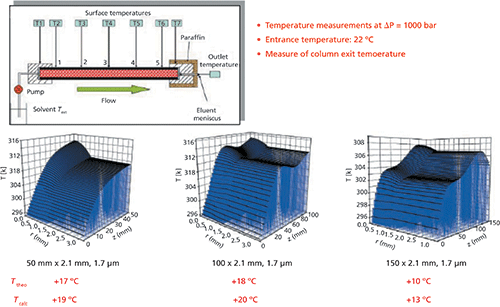
Figure 1: The experimental procedure and summary data from studies on the effect of longitudinal heating effects of UHPLC columns packed with 1.7-µm particles operating at 10,000 psi. Diagram reprinted with permission from reference 6. Copyright 2008 American Chemical Society.
For fast gradient analysis, it may take up to five injections to achieve thermal equilibration because of viscosity changes in the mobile phase during gradient analyses (13). For most UHPLC applications, it is important to acknowledge the existence of viscous heating. However, viscous heating may not be a serious issue, with the following exceptions: columns packed with very small particles (<2 µm) operating at high pressures (>1000 bar) with samples having critical pairs sensitive to temperature selectivity effects.
Operating Nuances and Backward Compatibility to Existing HPLC Methods
Although UHPLC has improved method performance (speed, resolution, precision, and efficiency) (9,10,14), many new users of UHPLC who are accustomed to HPLC operation are likely to experience some unexpected surprises and operating nuances. First, there could be a substantial cost premium of 10–50% compared to conventional HPLC equipment. Second, the use of smaller internal diameter columns packed with sub-2-µm particles using a low-dispersion instrument will require a better understanding of fundamental concepts, such as column void volume, peak volume, dwell volume, instrumental dispersion, and peak capacity-particularly during method development, method conversion, and troubleshooting (9,15). Some operational and fundamental training would be helpful for laboratory staff to ease the transition to UHPLC systems. Installing UHPLC column fittings correctly to minimize dead volume is also particularly important. A few manufacturers offer products to ensure tight column connections, such as the Agilent A-Line Quick Connect, Thermo Viper, and IDEX MarvelX fittings.
There may be issues regarding the compatibility of UHPLC systems in running conventional HPLC methods. These issues include limitations in flow rate (for example, <2 mL/min), injector sample loop size (<20 µL), and the column capacity of the column oven (<150 mm column length). Newer UHPLC equipment appears to be more backward compatible (for example, some new UHPLC column ovens introduced in 2016 are now able to accommodate columns up to 30-cm long). Most incompatibility issues can be readily resolved by installing optional accessories (that is, a larger sampling loop or syringe).
Historically, other issues of significant concern were column lifetime performance and the limited number of bonded phases available for UHPLC columns packed with sub-2-µm particles. Small-particle columns with smaller frit sizes are easily plugged from particulates (from both the mobile phase and the sample); therefore, higher levels of "chromatographic hygiene" and sample cleanup should be practiced (11). The availability of UHPLC columns was an initial limitation (only C18 and C8 bonded phases with column internal diameters ≤ 2.1 mm were available) during the debut of the first commercial UHPLC system in 2004. Since then, many UHPLC columns packed with sub-2-µm and sub-3-µm particles (both totally porous and superficially porous) have been introduced, including phases for different LC modes (ion exchange, chiral, hydrophilic interaction, and size exclusion) for the separation of both small molecules and biomolecules. Presently, both column lifetimes and the availability of columns and phases no longer appear to be issues of concern.
One trend, necessitated by the more sophisticated engineering of the UHPLC pumps and autosamplers, is in servicing key maintenance parts. As an example, the servicing of pump seals is now often handled by replacing the entire pump head with factory-refurbished parts rather than just replacing the pump seals on site by users or service personnel.
Injector Precision
Marginally acceptable peak area precision from early UHPLC X-Y-Z type autosamplers under partial-loop injection mode were reported (16,17). However, with continued improvements to UHPLC technology and the increased use of integrated-loop autosamplers, the precision of peak areas has improved significantly, even for small injection volumes (for example, <0.1–0.2% relative standard deviation [RSD] down to ~1 µL). An example of peak area and retention time precision data with different injection volumes is shown in Table I. These data demonstrate the excellent precision of <0.1% RSD at injection volumes of 10–20 µL, ~0.2% RSD at injection volume 1–5 µL, and ~0.5% RSD down to 0.2–0.5 µL. It should be noted that excellent peak area and retention time precision (<0.1% RSD) under high-resolution gradient analysis conditions at pressures of >12,000 psi have also been reported (18).
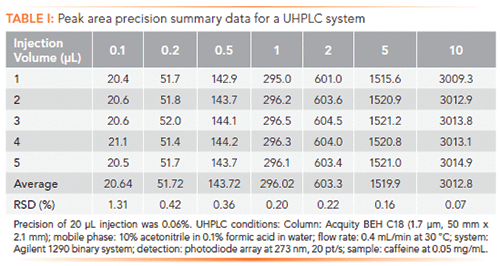
These data show that compliance with the United States Pharmacopeia (USP) precision requirements for chromatographic methods (see USP <621>) can easily be achieved.
UV Detector Sensitivity Issue from Pump Blending
The reduction of system dwell volumes is critical for high-throughput screening applications, and is usually achieved using high-pressure mixing binary pumps (1,10,14). However, if sufficient blending efficiency is not achieved, the low dwell volume may be problematic for high-sensitivity UV detection (1). For example, Figure 2 shows a UHPLC chromatogram of an analgesic drug product extract obtained using an early UHPLC system equipped with a binary pump and an external 100-µL mixer. The mobile phase of 11% acetonitrile in 0.1% acetic acid in water was pump-blended and the UV detector was set at 227 nm. Note that a periodic baseline perturbation is clearly visible. This perturbation was attributed to inadequate blending of mobile phase, considering that 0.1% acetic acid in water has significant absorbance at low UV wavelengths. The baseline perturbation, synchronous with piston strokes of pump B, can be eliminated by using premixed mobile phases or by adding larger mixing volumes to the system (for example, by using a 425-µL mixer) (1).
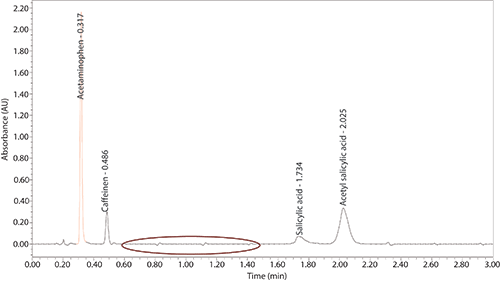
Figure 2: HPLC chromatogram illustrating the potential issue of UV baseline perturbation from insufficient blending efficiency from a binary UHPLC pump. Column: 50 mm x 3.0 mm, 3.5-µm dp XBridge C18; mobile-phase A: 0.1% acetic acid in water; mobile-phase B: acetonitrile; flow rate: 1.5 mL/min; temperature: 30 °C; pressure: 2700 psi; detection: 227 nm, 20 pt/s; sample: 1 µL of an analgesic tablet extract (Excedrin). This issue was resolved by replacing the standard 100-µL mixer with a peptide mapping mixer of 425 µL. See reference 1 for more details.
The severity of this UV baseline problem is a function of pump design, the piston (stroke) volume, the mixer volume, and the relative UV absorbance of the two solvents. This potential issue can be minimized using larger-volume mixers (which will increase dwell volumes) or by selecting pumps with micropistons, variable stroke volume capability, or a dual-piston in parallel pump design (10). Note that quaternary pumps have inherently larger dwell volumes (0.4–0.8 mL) and may not need external mixers (10). Readers are encouraged to consult with instrument manufacturers regarding the selection of appropriate mixers for high-sensitivity applications using UV detectors without adding excessive dwell volumes.
Method Translation: Conversion from HPLC to UHPLC Methods and Vice Versa
The pharmaceutical industry prefers "portable" HPLC methods that are usable by most laboratories to facilitate global manufacturing. Since UHPLC systems are not yet standard equipment in most laboratories, many newly developed UHPLC methods for regulatory assays are "converted" back to HPLC methods, using longer 3-µm or sub-3-µm columns. Theoretically, this conversion should be straightforward, by using geometric scaling of flow rates, gradient time (tG), and injection volumes, while keeping the same length to particle size (dp) ratio (19). In practice, fine-tuning the HPLC method is often needed for the International Conference on Harmonization (ICH)-compliant stability-indicating methods (1,2).
This process of method translation is often referred to as "method transfer" in the literature. This reference may be technically incorrect, because method transfer is the formal process of demonstrating that a validated analytical method developed in an originating laboratory can be properly executed by another laboratory operating in a good manufacturing practice (GMP) environment. The method transfer process is executed as directed in a written protocol, with pre-established acceptance criteria to ensure that accurate data can routinely be generated in the new laboratory (11,15). On the other hand, method translation is the process of method conversion between HPLC and UHPLC conditions to produce equivalent separations.
There are three scenarios for method translation between HPLC and UHPLC (11):
- Same HPLC methods implemented on different types of equipment (HPLC versus UHPLC)
- Newly developed UHPLC methods "back translated" to HPLC method conditions
- Existing HPLC methods translated to UHPLC methods for faster analysis
Running the Same HPLC Method on HPLC and UHPLC Systems
For laboratories with both HPLC and UHPLC equipment, it would be ideal if equivalent results could be obtained on both types of equipment. As shown in Figure 3, when executing an HPLC method using an identical column and mobile phase, results can be equivalent with the exception of retention time shifts because of the smaller dwell volumes (VD) of UHPLC systems (~0.1–0.7 mL by UHPLC versus ~1.0 mL by conventional HPLC) (15). In general, the earlier retention times by UHPLC will not impact resolution and, if needed, can be remedied by several means (11):
- Increasing the dwell volume of the UHPLC system, by using a larger external mixer
- Building an initial isocratic segment into the HPLC method and allowing the user to adjust the duration of this segment in the method (preferred)
- Using simulation software available on some chromatography data systems to simulate the performance of different instrument models by automatic method adjustments (21), or by purchasing a dual-path system that converts a UHPLC system into an HPLC system with a switching valve to select a larger flow path (21)
Note that detection sensitivity is generally not impacted when similar UV detectors and flow cells are used except for early eluted peaks where UHPLC systems often yield a slightly higher signal because of lower system dispersion.
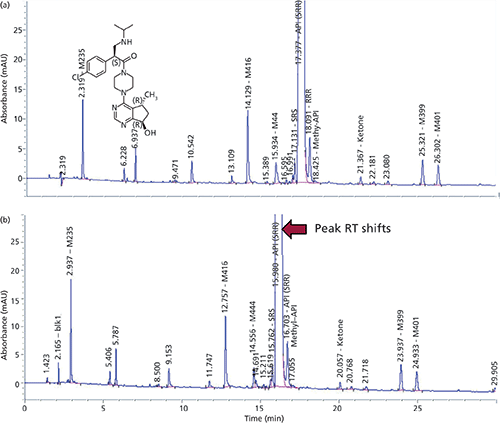
Figure 3: Comparative HPLC chromatograms of the retention marker solution of a stability-indicating method for a multichiral drug substance on (a) HPLC (Agilent 1200 quaternary system) and (b) UHPLC systems (Agilent 1290 binary system) under identical column and mobile-phase conditions. Column: ACE C18, (3 µm, 150 mm x 4.6 mm); mobile-phase A: 20 mM ammonium formate at pH 3.7; mobile-phase B: acetonitrile with 0.05% formic acid; gradient: 5–15% B in 5 min, 15–40% B in 25 min, 40–90% B in 3 min; flow rate: 1.0 mL/min at 300 °C and 200 bar; detection: UV at 280 nm, 40 pt/s; sample: 10 µL of a 0.5-mg/mL solution of an active pharmaceutical ingredient (API) spiked with expected impurities. Note that UV detector baseline noise is comparable at ~0.02 mAU while the retention time shifted earlier by 0.8 to 1.4 min on the UHPLC system because of the smaller dwell volume (0.28 mL versus 1 mL on the HPLC system). Structure of the multichiral API is shown in the inset. Chromatograms reproduced with permission from reference 11.
Back-Conversion of UHPLC Methods to HPLC Method Conditions
Many laboratories use UHPLC for rapid method development including column and mobile-phase screening and method optimization (19). The optimized UHPLC methods are "back translated" to HPLC conditions using longer columns via geometric scaling. Only the back-converted HPLC method needs to be validated and serves as the primary regulatory method to support global manufacturing operations while the faster UHPLC method can be used to support any non-GMP process development projects. Case studies for such method conversion processes have been previously reported (1).
Conversion of Existing HPLC Methods to Faster UHPLC Methods
The primary driver for purchasing UHPLC equipment is the ability to perform faster analysis with "good" resolution (20). To duplicate the separation with similar column efficiency and selectivity, this can be accomplished by geometric scaling using the following ground rules:
- Column length (L) is scaled to particle size (dp keeping the L/dp ratios the same. The bonded phase chemistry must be identical. For example, Acquity (1.7 µm, 50 mm x 2.1 mm)–XBridge (3.5 µm, 100 mm x 3.0 mm)
- Flow rate (F) is scaled to the cross-sectional area of the column. For example, 2.1 mm i.d. (0.5 mL/min), 3.0 mm i.d. (1 mL/min), 4.6 mm i.d. (2 mL/min)
- Gradient time (tG is scaled to column length at a geometrically identical flow rate
- Sample injection volume is scaled to column void volume. For example, 2 µL (1.7 µm, 50 mm x 2.1 mm) to 10 µL (3.5 µm, 100 mm x 3.0 mm)
One requirement is that both HPLC and UHPLC columns must contain the identical bonded phase materials, to eliminate any selectivity differences. Also, the mobile phases used should be identical (type of buffer, strength, pH, organic modifier, and so forth). An example of this method conversion is shown in Figure 1 of the second installment of this series (18). Calculator programs for method translation are available at various vendors' websites (Waters, Agilent, and Thermo) and other sources (11).
In practice, the ground rules of geometric scaling may not be strictly followed if equivalent or better resolution can be achieved with UHPLC columns. Figure 4 shows a case study for the conversion of a 42-min regulatory HPLC method of a multichiral drug to UHPLC methods of equal or higher resolution. Here, geometric scaling was not followed since the flow rate of 1 mL/min of the original HPLC method is not optimum to begin with. The faster 17-min method with equivalent resolution was used to support Phase 2 drug product development (18).
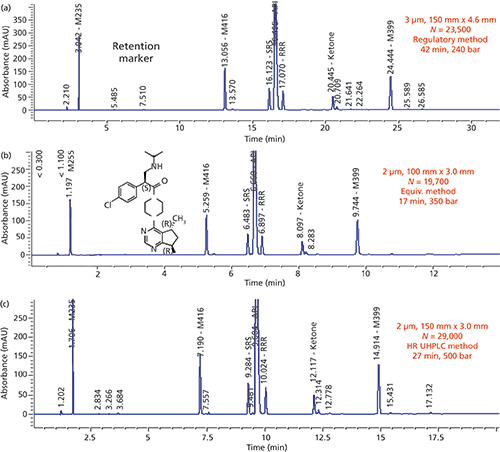
Figure 4: Comparative chromatograms of a retention marker solution containing an API (0.5 mg/mL) and spiked impurities analyzed using identical mobile phases on an Agilent 1290 binary UHPLC system by various methods: (a) Regulatory HPLC, (b) fast HPLC, (c) UHPLC. Run time, operating pressure, column, plate count, and resolution values of the diastereomers are shown in the figure. HPLC conditions: (a) regulatory HPLC method: same as in Figure 3. (b) Fast HPLC method: column: ACE C18, (2 µm, 100 mm x 3.0 mm); flow rate: 0.8 mL/min at 40 °C; gradient: 5–15% B in 2 min, 15–40% B in 10 min, 40-90% B in 1 min, 90% B in 2 min, 90–5% B in 0.1 min; injection volume = 3 µL. (c) UHPLC method: column: ACE C18, (2 µm, 150 mm x 3.0 mm); flow rate: 0.8 mL/min at 40 °C; gradient: 5-15% B in 2 min, 15–40% B in 18 min, 40–90% B in 3 min, 90% B in 2 min, 90–5% B in 0.1 min; injection volume = 5 µL. Structure of the multichiral API is shown in the inset. Chromatograms reproduced with permission from reference 18.
Most of the reported method translation case studies have been for reversed-phase separations for small-molecule drugs, for which the retention mechanism is highly predictable and substantial cumulative manufacturing experience with small-particle bonded phases is available. Successes with method translation case studies in other chromatographic modes such as size exclusion, normal-phase chiral, ion exchange, and hydrophilic interaction are reported less often and perhaps they are less predictable.
Method Validation Requirements After Method Translation
For validated HPLC methods, there has been a lot of discussion and considerable confusion regarding what constitutes a method adjustment versus a method change and whether revalidation of the converted UHPLC method is needed (26). The current consensus, including viewpoints from a United States Food and Drug Administration (FDA) reviewer, is that a partial method validation (including specificity, intermediate precision, linearity, and robustness) is needed. The validation should include supporting data on method equivalency between the original and the converted methods. For USP methods, the Chromatograph Chapter <621> in USP 37-NF32 (including supplement 1) of 2014 offers guidelines on permissible method adjustments to pass system suitability testing. In general, injection volume, column temperature (±10%), and mobile-phase pH (±10%) can be adjusted without revalidation. For isocratic methods, wide adjustment ranges of column particle size, column length, flow rate, and column internal diameter are allowed. In contrast, no such changes are allowed for gradient methods.
How to Transition from HPLC to UHPLC: Instrumental Considerations
This final section discusses how to get started in UHPLC by selecting the appropriate UHPLC instrument vendor and model. The decision may be a complex one, since there are many UHPLC models available from numerous manufacturers with diverse features, pricing, and control software (22–25,27). Table II lists UHPLC systems from several major manufacturers with their associated data and mass spectrometry (MS) systems as well as the maximum flow rate and pressure limit.
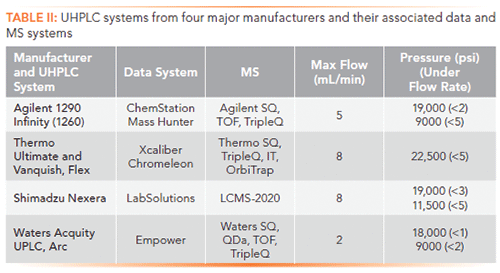
The purchase decision should be driven by the intended application-whether it is for method development, routine testing, research, quality control, high-throughput screening, or LC–MS analysis-and should be dictated by the most appropriate features available in a specific vendor or model. The second consideration should be whether the instrument is compatible with your existing chromatography data system (CDS) (likely a client-server CDS in most laboratories). With respect to CDS compatibility, the best UHPLC system is often the one supplied by the same CDS manufacturer. This is particularly important for UHPLC–MS systems, in which HPLC control is embedded in the MS data system. For laboratories wishing to run existing HPLC methods, specific vendors may offer UHPLC systems with better backward compatibility.
After selecting the manufacturer, the next consideration is the choice of the specific model and the optional accessories. Pricing is highly variable for UHPLC systems (>15,000 psi) and lower-cost intermediate-pressure HPLC systems or dual-path systems (~10,000 psi) (22–25). The cost for binary pumps is usually higher than for quaternary pumps. Biocompatible titanium-based systems are preferred for bioanalysis of proteins, which typically requires high-salt mobile phases. Quaternary pumps, with built-in switching valves and column ovens, are typical with method development systems. For binary systems used for high-sensitivity purity assays (including peptide mapping), larger external mixers should be selected.
In this mature UHPLC market, most manufacturers offer reliable and competitive products, whose actual specifications (for example, upper pressure limits, autosampler precision, and system dispersion) may have little practical significance in daily operation.
Conclusions
The final entry of this three-part series on UHPLC provided an overview of the potential issues and concerns of running UHPLC methods and the means for their mitigation. Purchasing considerations for UHPLC systems were also discussed.
Acknowledgments
The authors would like to thank Tom Waeghe of MAC-MOD Analytical, Wilhad Reuter of PerkinElmer, Raphael Ornaf (retired), Hernan Fuentes of Ardelyx, Terence Lo from Gilead Sciences, Matt Mullaney of Pentec Health, and Davy Guillarme of the University of Geneva for their technical and editorial inputs.
References
(1) M.W. Dong, LCGC North Am. 25(7), 656–666, (2007).
(2) M.W. Dong, in Chromatography: A Science of Discovery, R.L. Wixom and C.L. Gehrke, Eds. (Wiley, Hoboken, New Jersey, 2010), pp. 328–333.
(3) Y. Xiang, D. Maynes, and M.L. Lee, J. Chromatogr. A 991, 189–196 (2003).
(4) N. Wu and A.M. Clausen, J. Sep. Sci.30, 1167–1187 (2007).
(5) L. Nováková, J-L. Veuthey, and D. Guillarme, J. Chromatogr. A 1218, 7971–7981 (2011).
(6) F. Gritti and G. Guiochon, Anal. Chem . 80, 5009–5020 (2008).
(7) A. de. Villers, F. Lestremau R. Szucs, S. Gelebart, F. David, and P. Sandra, J. Chromatogr. A 1127(1–2), 60–69 (2006).
(8) D. Cabooter and G. Desmet, in UHPLC in Life Sciences, D. Guillarme, J.-L. Veuthey, and R. M Smith, Eds. (Royal Soc. Chem. Publishing, Cambridge, United Kingdom, 2012), Chapter 1.
(9) U.D. Neue, M. Kele, B. Bunner, A. Kromidas, T. Dourdeville, J.R. Mazzeo, E.S. Grumbach, S. Serpa, T.E. Wheat, P. Hong, and M. Gilar, in Advances in Chromatogr. 48 (CRC Press, Boca Raton, Florida, 2009), pp. 99–143.
(10) J. De Vos, K. Broeckhoven, and E. Eeltin, Anal. Chem. 88, 262–278, (2016).
(11) M.W. Dong, LCGC North Am. 31(10), 868–880, (2013).
(12) B. Debrus, E. Rozet, P. Hubert, J-L Veuthey, S. Rudaz, and D Guillarme, in UHPLC in Life Sciences, D. Guillarme and J-L Veuthey, Eds. (Royal Soc. Chem. Publishing, Cambridge, United Kingdom, 2012), pp. 67–98.
(13) M. Dittmann, K. Choikhet, P. Stemer, and K. Witt, "Method Transfer between HPLC and UHPLC: Issues and Solutions," presented at Pittcon 2011, Chicago, Illinois, 2011.
(14) M.W. Dong, LCGC North Am. 35(6), 374–381 (2017).
(15) M.W. Dong, Modern HPLC for Practicing Scientists (Wiley, Hoboken, New Jersey, 2006), chapters 2–4, 6, 9.
(16) S.A. Wren and P. Tchelitcheff, J. Chromatogr A. 1119(1–2), 140–146 (2006).
(17) L. Nováková, L. Matysová, and P. Solich, Talanta 68(3), 908–918 (2006).
(18) M. Dong, D. Guillarme, S. Fekete, R. Rangelova, J. Richards, D. Prudhomme, and N. Chetwyn, LCGC North Am. 32(11), 868–76, (2014).
(19) M.W. Dong and K. Zhang, Trends in Anal. Chem. 63, 21-30, 2014.
(20) M.W. Dong, LCGC North Am. 35(8), 486–495 (2017).
(21) Agilent 1290 Infinity LC with Intelligent System Emulation Technology, Agilent Technologies, 20135990-8670EN, 2013.
(22) M.W. Dong, LCGC North Am. 34(4), 262–273 (2016).
(23) M.W. Dong, LCGC North Am. 33(4), 254–261 (2015).
(24) M.W. Dong, LCGC North Am. 32(4), 270–279 (2014).
(25) M.W. Dong, LCGC North Am. 31(4), 313–325 (2013).
(26) M. Swartz and I. Krull, LCGC North Am. 24(8), 480–490 (2006).
(27) "UHPLC: Where We are Ten Years After Its Commercial Introduction," D. Guillarme and M.W. Dong, Eds., Trends in Anal. Chem. 63, 1–188, (2014) (a special issue).
ABOUT THE COLUMN EDITOR
Michael W. Dong

Michael W. Dong , is a principal of MWD Consulting, which provides training and consulting services in HPLC and UHPLC, pharmaceutical analysis, and drug quality. He was formerly a Senior Scientist at Genentech, Research Fellow at Purdue Pharma, and Senior Staff Scientist at Applied Biosystems/PerkinElmer. He holds a PhD in Analytical Chemistry from City University of New York. He has more than 100 publications and a best-selling book in chromatography. He is an editorial advisory board member of LCGC North America. Direct correspondence to: LCGCedit@ubm.com

New Study Reviews Chromatography Methods for Flavonoid Analysis
April 21st 2025Flavonoids are widely used metabolites that carry out various functions in different industries, such as food and cosmetics. Detecting, separating, and quantifying them in fruit species can be a complicated process.
Extracting Estrogenic Hormones Using Rotating Disk and Modified Clays
April 14th 2025University of Caldas and University of Chile researchers extracted estrogenic hormones from wastewater samples using rotating disk sorption extraction. After extraction, the concentrated analytes were measured using liquid chromatography coupled with photodiode array detection (HPLC-PDA).

.png&w=3840&q=75)

.png&w=3840&q=75)



.png&w=3840&q=75)



.png&w=3840&q=75)







